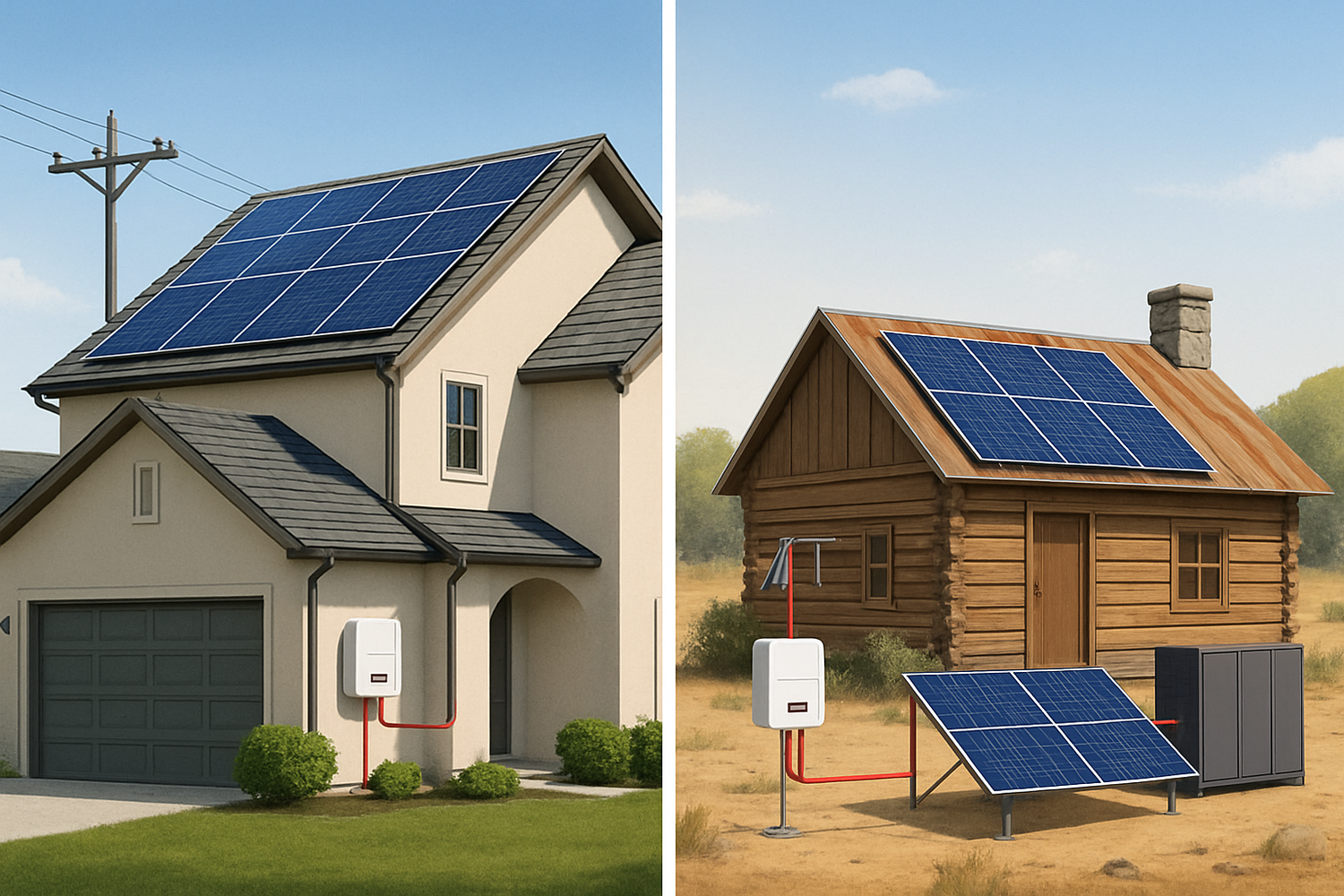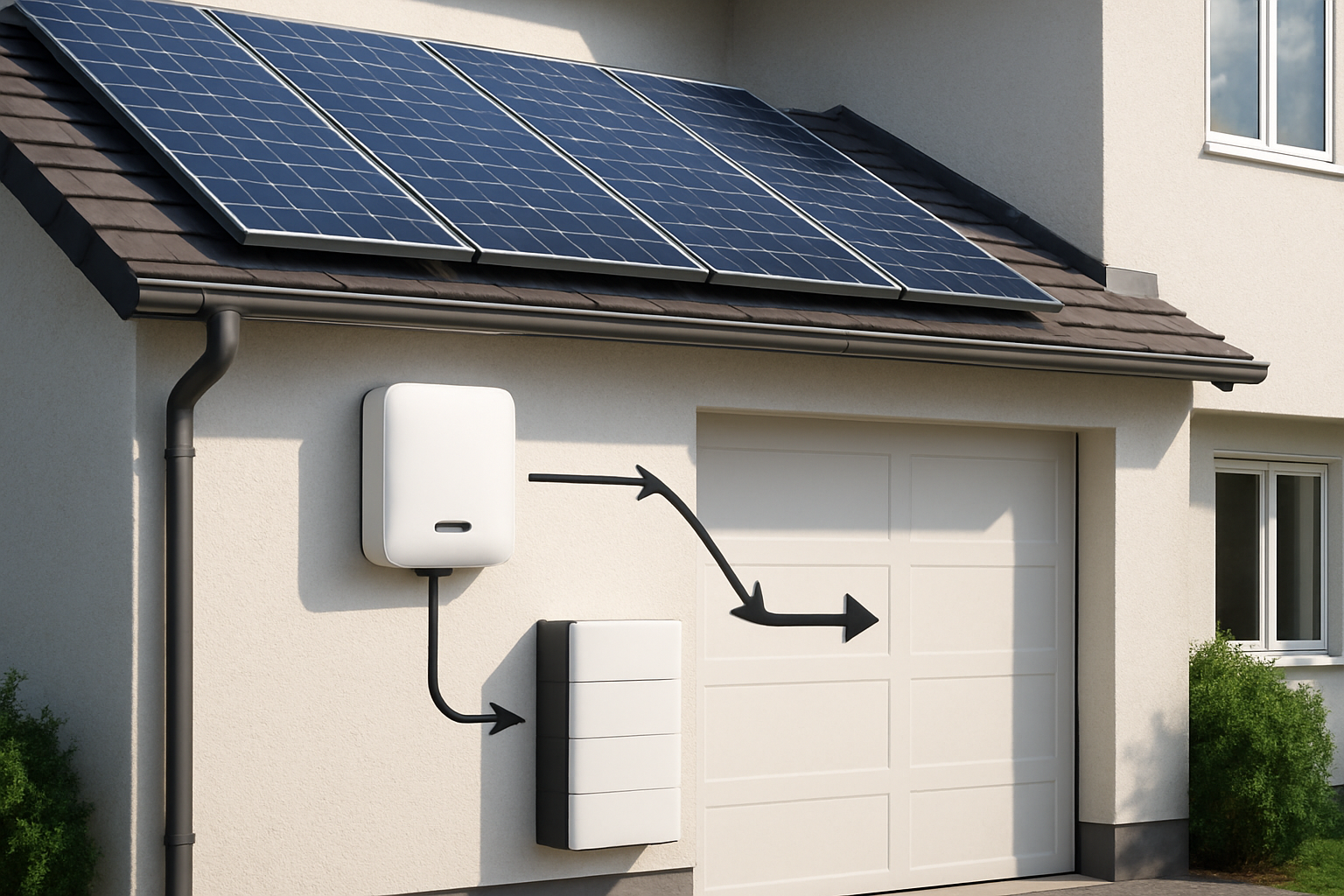Choosing to adopt solar power is a significant step toward managing your energy costs and reducing your environmental footprint. Once you make that decision, a fundamental choice awaits: should your system be connected to the utility grid, or should it stand completely on its own? This decision shapes your system's cost, performance, and your level of energy independence. This guide provides a clear solar power comparison, examining the structures, benefits, and considerations for grid-tied, off-grid, and hybrid solar systems to help you select the right path.
How Grid-Tied Solar Systems Work
Grid-tied systems are the most common type of solar installation for homes and businesses. As the name suggests, they are directly connected to the public utility grid, allowing for a two-way relationship where you can both draw power from and send power to the grid.
The Connection to the Utility Grid
In a grid-tied setup, the solar panels on your roof generate direct current (DC) electricity when exposed to sunlight. This DC power is sent to an inverter, which converts it into alternating current (AC) electricity—the type of power used by your home appliances. The system prioritizes using this solar power first. If you generate more electricity than you consume, the surplus is exported to the utility grid. Conversely, at night or on cloudy days when your panels aren't producing enough power, your home seamlessly draws electricity from the grid. This process is often managed through a policy called net metering.
Key Components and Net Metering
The core components of a grid-tied system are relatively simple: solar panels and a grid-tied inverter. A special utility meter, often called a net meter or a bi-directional meter, is also installed. This meter tracks the electricity you pull from the grid and the excess energy you send back. According to information from the U.S. Department of Energy, net metering policies allow you to receive credits for the surplus energy you generate, which can offset the cost of the electricity you use from the grid. These policies are crucial for the financial viability of many residential solar projects.
Advantages and Disadvantages of Grid-Tied Systems
Grid-tied systems offer several benefits, primarily related to cost and simplicity. However, their reliance on the grid is a key limitation.
| Advantages | Disadvantages |
|---|---|
| Lower initial cost due to fewer components (no batteries required). | No power during a grid outage for safety reasons. |
| The grid acts as a massive, 100% efficient 'battery'—no energy is wasted. | Dependence on utility company policies, such as net metering rates. |
| Potential to earn credits or payments for excess energy production. | You are not truly energy independent. |
| Lower maintenance requirements compared to off-grid systems. | Rising electricity rates can still affect your overall energy costs. |
Understanding Off-Grid Solar Systems
Off-grid solar systems operate independently of the utility grid, providing complete energy self-sufficiency. These systems are essential for properties in remote locations without grid access or for individuals who desire total control over their power supply.
Achieving True Energy Independence
An off-grid system generates and stores its own electricity. This means you are your own utility. All the power you produce is either used immediately or stored in a battery bank for later use, such as at night or during periods of poor weather. This setup provides immunity from public power outages and rising utility rates. Success with an off-grid system requires careful planning of energy production and consumption to ensure a consistent power supply.
Essential Components for Self-Sufficiency
Off-grid solar systems are more complex than their grid-tied counterparts. The critical components include:
- Solar Panels: To capture energy from the sun.
- Charge Controller: To regulate the voltage and current from the panels to the batteries, preventing overcharging.
- Battery Bank: The heart of the system, storing energy for later use. Modern lithium iron phosphate (LiFePO4) batteries are a popular choice due to their long lifespan, high efficiency, and safety.
- Off-Grid Inverter: To convert DC electricity from the batteries into AC power for your home.
- Backup Generator (Recommended): Provides a safety net for extended periods of bad weather or unusually high energy demand.
Advantages and Disadvantages of Off-Grid Systems
Going off-grid offers the ultimate freedom but comes with greater responsibility and cost.
| Advantages | Disadvantages |
|---|---|
| Complete energy independence from utility companies. | Significantly higher upfront cost due to the need for batteries and other components. |
| No monthly electricity bills. | Power availability depends on weather and system capacity. |
| Immunity to grid failures and blackouts. | Requires careful energy management and consumption monitoring. |
| Suitable for remote locations where grid connection is impossible or expensive. | System maintenance is more involved, including battery health monitoring. |
Head-to-Head Comparison: Key Decision Factors
Choosing between these systems involves weighing cost, reliability, and your personal energy goals. The International Renewable Energy Agency (IRENA) notes that falling costs for both solar PV and battery storage are making both options more accessible globally.
Cost and Financial Viability
The primary financial difference is the upfront investment. Off-grid solar systems are more expensive due to the necessity of a large battery bank, a charge controller, and often a backup generator. Grid-tied systems avoid these costs, making them more affordable to install. However, an off-grid system eliminates monthly electricity bills entirely, while a grid-tied system owner may still have some charges from their utility. The long-term financial picture depends on local electricity rates, available solar incentives, and the cost of system maintenance.
Reliability and Power Availability
Reliability is a nuanced topic. Grid-tied systems are as reliable as the utility grid itself. However, data from the U.S. Energy Information Administration (EIA) shows that weather events can cause significant disruptions to grid stability. During an outage, a standard grid-tied system must shut down for safety. An off-grid system is immune to these public blackouts. Its reliability is instead tied to its design, the local climate, and your energy usage habits. A properly sized system with a quality lithium battery bank can provide a highly reliable power supply.
Maintenance and System Management
Grid-tied systems generally require minimal maintenance—mostly keeping the solar panels clean and ensuring the inverter is functioning correctly. Off-grid systems demand a more hands-on approach. You are responsible for monitoring the state of charge of your batteries, managing your energy consumption to avoid draining the bank, and performing regular checks on all components. While modern energy storage solutions with advanced battery management systems simplify this, the owner still plays an active role as the system operator.
The Rise of Hybrid Solar Systems
A third option, the hybrid solar system, offers a compromise by combining features from both grid-tied and off-grid setups. It connects to the utility grid but also includes a battery bank for energy storage.
Combining Grid-Tied Benefits with Battery Backup
A hybrid system operates like a grid-tied system most of the time, using solar power, pulling from the grid when needed, and sending excess power back. The key difference is the battery. The system can be programmed to store excess solar energy in the battery instead of sending it to the grid. This stored energy can then be used at night or, crucially, as a backup power source during a grid outage. This gives homeowners the best of both worlds: the financial benefits of net metering and the security of backup power. Understanding the performance metrics of solar storage is crucial. As detailed in the ultimate reference on solar storage performance, factors like Depth of Discharge (DoD) and battery cycle life directly impact the long-term value of a hybrid system.
Making the Right Choice for Your Energy Future
Ultimately, the ideal solar solution is not one-size-fits-all. A grid-tied system is often a practical choice for those in areas with a reliable grid and favorable net metering policies. An off-grid system is the definitive solution for achieving energy independence, especially in remote areas. The hybrid system is emerging as a powerful alternative for those who want grid-tied economics with off-grid resilience. By evaluating your location, budget, and desire for energy autonomy, you can confidently choose the system that aligns with your goals.
Disclaimer: This article is for informational purposes only and does not constitute financial or investment advice. Consult with a qualified professional before making any decisions about installing a solar energy system.
Frequently Asked Questions
Can a grid-tied system power my home during an outage?
Typically, no. For safety reasons, standard grid-tied inverters automatically shut down when they detect a grid failure. This prevents them from sending power back into the grid lines and endangering utility workers. To have backup power during an outage, you need a system with battery storage, such as a hybrid or off-grid system.
How large of a battery bank do I need for an off-grid system?
The size of your battery bank depends on your daily energy consumption, the number of 'days of autonomy' you need (days you can run without solar input), and the size of your solar array. A professional installer will conduct an energy audit to calculate your loads and recommend an appropriately sized battery bank. Using high-performance lithium ion phosphate batteries can often provide more usable energy in a smaller, lighter package.
What is net metering and is it available everywhere?
Net metering is a utility billing mechanism that credits solar system owners for the electricity they add to the grid. The availability and terms of these policies vary significantly by country, state, and even by the specific utility company. According to the International Energy Agency (IEA), supportive policies like net metering are a key driver for the adoption of distributed solar energy. It is important to research your local regulations.
Are off-grid solar systems difficult to maintain?
Modern off-grid systems, particularly those using durable components like 12v 100ah LiFePO4 lithium batteries, require less maintenance than older systems that used traditional lead-acid batteries. However, they do require more oversight than grid-tied systems. This includes periodic checks of battery status, connections, and ensuring solar panels are clean and unobstructed.





Leave a comment
All comments are moderated before being published.
This site is protected by hCaptcha and the hCaptcha Privacy Policy and Terms of Service apply.